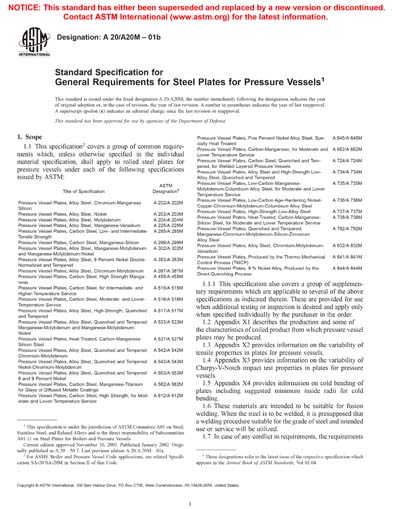Historical
ASTM A20/A20M-01b
Standard Specification for General Requirements for Steel Plates for Pressure Vessels
This specification covers a group of common requirements which, unless otherwise specified in the individual material specification, shall apply to rolled steel plates for pressure vessels under each of the following specifications issued by ASTM: Title of SpecificationASTMDesignation Pressure Vessel Plates, Alloy Steel, Chromium-Manganese Silicon A202/A202MPressure Vessel Plates, Alloy Steel, Nickel A203/A203MPressure Vessel Plates, Alloy Steel, MolybdenumA204/A204MPressure Vessel Plates, Alloy Steel, Manganese-Vanadium A225/A225MPressure Vessel Plates, Carbon Steel, Low- and Intermediate-Tensile Strength A285/A285MPressure Vessel Plates, Carbon Steel, Manganese-Silicon A299/A299MPressure Vessel Plates, Alloy Steel, Manganese-Molybdenum and Manganese-Molybdenum-NickelA302/A302MPressure Vessel Plates, Alloy Steel, 9 Percent Nickel Double-Normalized and Tempered A353/A353MPressure Vessel Plates, Alloy Steel, Chromium-Molybdenum A387/A387MPressure Vessel Plates, Carbon Steel, High Strength ManganeseA455/A455MPressure Vessel Plates, Carbon Steel, for Intermediate- and Higher-Temperature Service A515/A515MPressure Vessel Plates, Carbon Steel, Moderate- and Lower-Temperature Service A516/A516MPressure Vessel Plates, Alloy Steel, High-Strength, Quenched and Tempered A517/A517MPressure Vessel Plates, Alloy Steel, Quenched and Tempered Manganese-Molybdenum and Manganese-Molybdenum- NickelA533/A533MPressure Vessel Plates, Heat-Treated, Carbon-Manganese-Silicon Steel A537/A537MPressure Vessel Plates, Alloy Steel, Quenched and Tempered Chromium-Molybdenum A542/A542MPressure Vessel Plates, Alloy Steel, Quenched and Tempered Nickel-Chromium-Molybdenum A543/A543MPressure Vessel Plates, Alloy Steel, Quenched and Tempered 8 and 9 Percent NickelA553/A553MPressure Vessel Plates, Carbon Steel, Manganese-Titanium for Glass or Diffused Metallic CoatingsA562/A562MPressure Vessel Plates, Carbon Steel, High Strength, for Moderate and Lower Temperature ServiceA612/A612MPressure Vessel Plates, Five Percent Nickel Alloy Steel, Specially Heat TreatedA645/A645MPressure Vessel Plates, Carbon-Manganese, for Moderate and Lower Temperature ServiceA662/A662MPressure Vessel Plates, Carbon Steel, Quenched and Tempered, for Welded Layered Pressure VesselsA724/A724MPressure Vessel Plates, Alloy Steel and High-Strength Low-Alloy Steel, Quenched and TemperedA734/A734MPressure Vessel Plates, Low-Carbon Manganese-Molybdenum-Columbium Alloy Steel, for Moderate and Lower Temperature Service A735/A735MPressure Vessel Plates, Low-Carbon Age-Hardening Nickel-Copper-Chromium-Molybdenum-Columbium Alloy SteelA736/A736MPressure Vessel Plates, High-Strength Low-Alloy Steel A737/A737MPressure Vessel Plates, Heat-Treated, Carbon-Manganese-Silicon Steel, for Moderate and Lower Temperature ServiceA738/A738MPressure-Vessel Plates, Quenched and Tempered, Manganese-Chromium-Molybdenum-Silicon-Zirconium Alloy SteelA782/A782MPressure Vessel Plates, Alloy Steel, Chromium-Molybdenum-Vanadium A832/A832MPressure Vessel Plates, Produced by the Thermo-Mechanical Control Process (TMCP) A841/A841M Pressure Vessel Plates, 9 % Nickel Alloy, Produced by the Direct-Quenching ProcessA844/A844M 1.1.1 This specification also covers a group of supplementary requirements which are applicable to several of the above specifications as indicated therein. These are provided for use when additional testing or inspection is desired and apply only when specified individually by the purchaser in the order. 1.2 Appendix X1 describes the production and some of the characteristics of coiled product from which pressure vessel plates may be produced. 1.3 Appendix X2 provides information on the variability of tensile properties in plates for pressure vessels.1.4 Appendix X3 provides information on the variability of Charpy-V-Notch impact test properties in plates for pressure vessels. 1.5 Appendix X4 provides information on cold bending of plates including suggested minimum inside radii for cold bending.1.6 These materials are intended to be suitable for fusion welding. When the steel is to be welded, it is presupposed that a welding procedure suitable for the grade of steel and intended use or service will be utilized. 1.7 In case of any conflict in requirements, the requirements of the individual material specification shall prevail over those of this general specification. 1.8 The purchaser may specify additional requirements which do not negate any of the provisions of this general specification or of the individual material specifications. Such additional requirements, the acceptance of which are subject to negotiation with the supplier, must be included in the order information (see 4.1.8).1.9 For purposes of determining conformance with this specification and the various material specifications referenced in 1.1, values shall be rounded to the nearest unit in the right-hand place of figures used in expressing the limiting values in accordance with the rounding method of Practice E29.1.10 The values stated in either inch-pound units or SI units are to be regarded as standard. Within the text, the SI units are shown in brackets. The values stated in each system are not exact equivalents. Therefore, each system must be used independently of the other. Combining values from the two systems may result in nonconformance with this specification. 1.11 This specification and the applicable material specifications are expressed in both inch-pound units and SI units. However, unless the order specifies the applicable "M" specification designation (SI units), the material shall be furnished to inch-pound units.
ASTM International [astm]

